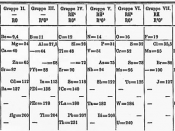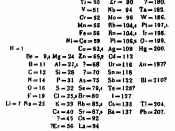Have you ever really studied a lightbulb? If you have, you wouldn't see much. However, inside there is an invisible gas called Argon. Argon is an element on the periodic table. An element, in simple terms, is any one of the more than hundred basic substances or materials from which all other things are made. An element has atoms of only one kind and can't be broken down into any simpler substance by ordinary chemical means. This essay is going to be taking a look at one of the many elements on the periodic table, called Argon.
Argon was first discovered in 1984 by Lord Raleigh and Sir William Ramsay. It is a colorless, odorless, and tasteless gas. It does not react with other chemicals, so therefore it is inert. It has an atomic number of 18, meaning that it has 18 protons. It has an atomic weight of 39.948.
Its density is 1.784 g/cmÃÂó.
According to the Webster's International Encyclopedia, the periodic table is the table of elements in order of increasing atomic number. It is arranged in rows and columns to illustrate periodic similarities and trends in physical and chemical properties. In 1869 Dmitri Mendeleev published the first fairly complete periodic table, which was later revised by Henry Moseley. Each of the seven rows, or periods, of the table contains elements that have the same number of electron shells. The elements are arranged in vertical columns, or groups, containing elements of similar atomic structure and properties. The nonmetals are located in the upper right-hand corner on the periodic table. About 80 percent of the elements are metals. Therefore, these occupy a huge portion of the periodic table. The metalloids of the periodic table border both sides of the "line"ÃÂ that separate the metals from the nonmetals. The...



Argon
nice essay and good info could have been a super essay if it just had references such a shame.
0 out of 0 people found this comment useful.